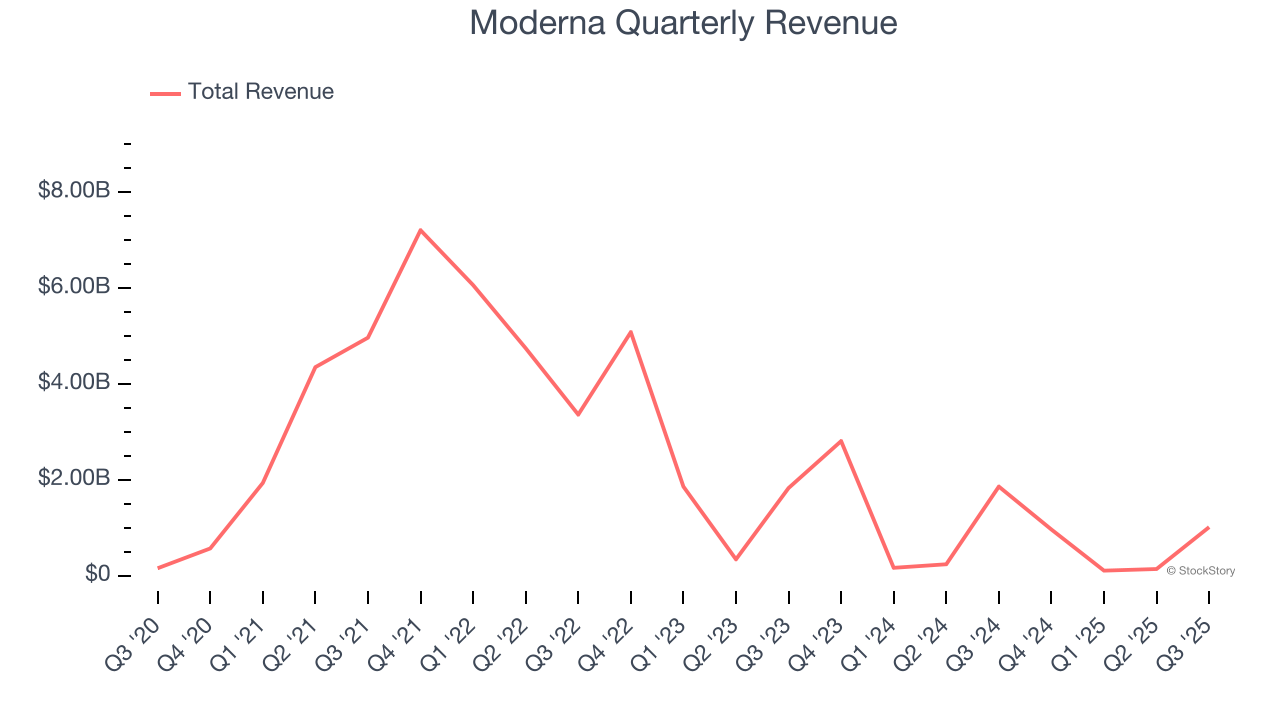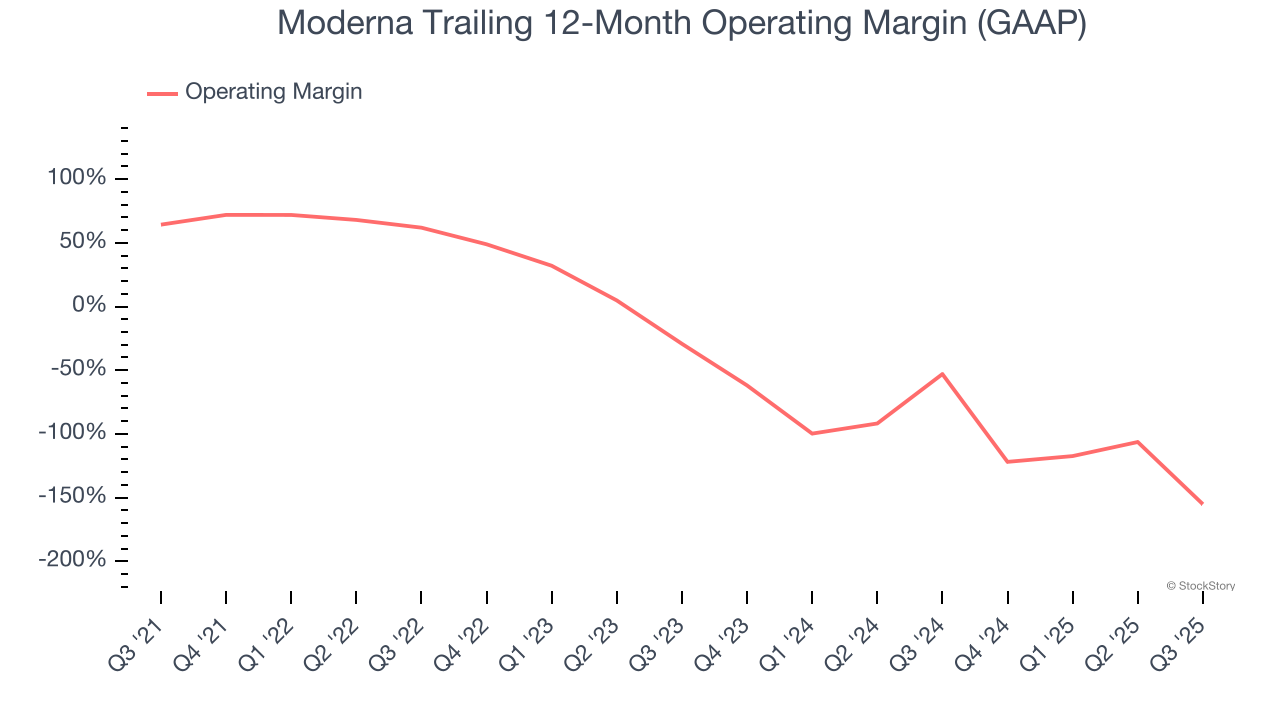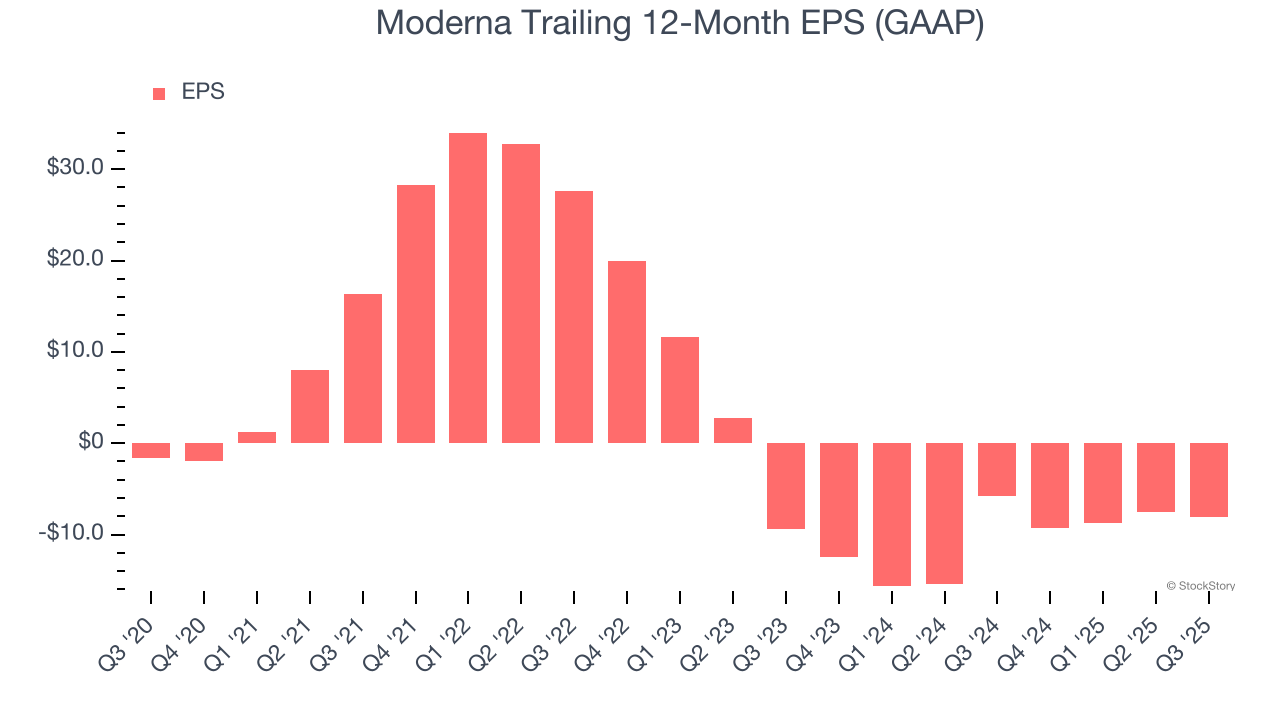
Biotechnology company Moderna (NASDAQ: MRNA) beat Wall Street’s revenue expectations in Q3 CY2025, but sales fell by 45.4% year on year to $1.02 billion. On the other hand, the company’s full-year revenue guidance of $1.8 billion at the midpoint came in 4.4% below analysts’ estimates. Its GAAP loss of $0.51 per share was 78.6% above analysts’ consensus estimates.
Is now the time to buy Moderna? Find out by accessing our full research report, it’s free for active Edge members.
Moderna (MRNA) Q3 CY2025 Highlights:
- Revenue: $1.02 billion vs analyst estimates of $769.6 million (45.4% year-on-year decline, 32% beat)
- EPS (GAAP): -$0.51 vs analyst estimates of -$2.38 (78.6% beat)
- The company dropped its revenue guidance for the full year to $1.8 billion at the midpoint from $1.85 billion, a 2.7% decrease
- Operating Margin: -25.6%, down from -3.8% in the same quarter last year
- Free Cash Flow was -$880 million compared to -$1.72 billion in the same quarter last year
- Market Capitalization: $9.20 billion
Company Overview
Rising to global prominence during the COVID-19 pandemic with one of the first effective vaccines, Moderna (NASDAQ: MRNA) develops messenger RNA (mRNA) medicines that direct the body's cells to produce proteins with therapeutic or preventive benefits for various diseases.
Revenue Growth
Reviewing a company’s long-term sales performance reveals insights into its quality. Any business can put up a good quarter or two, but many enduring ones grow for years. Luckily, Moderna’s sales grew at an incredible 55.3% compounded annual growth rate over the last five years. Its growth beat the average healthcare company and shows its offerings resonate with customers.

We at StockStory place the most emphasis on long-term growth, but within healthcare, a half-decade historical view may miss recent innovations or disruptive industry trends. Moderna’s recent performance marks a sharp pivot from its five-year trend as its revenue has shown annualized declines of 50.5% over the last two years. 
This quarter, Moderna’s revenue fell by 45.4% year on year to $1.02 billion but beat Wall Street’s estimates by 32%.
Looking ahead, sell-side analysts expect revenue to decline by 18.3% over the next 12 months. Although this projection is better than its two-year trend, it’s hard to get excited about a company that is struggling with demand.
While Wall Street chases Nvidia at all-time highs, an under-the-radar semiconductor supplier is dominating a critical AI component these giants can’t build without. Click here to access our free report one of our favorites growth stories.
Operating Margin
Moderna has been an efficient company over the last five years. It was one of the more profitable businesses in the healthcare sector, boasting an average operating margin of 24.2%.
Looking at the trend in its profitability, Moderna’s operating margin decreased significantly over the last five years. The company’s two-year trajectory also shows it failed to get its profitability back to the peak as its margin fell by 125.9 percentage points. This performance was poor no matter how you look at it - it shows its expenses were rising and it couldn’t pass those costs onto its customers.

In Q3, Moderna generated an operating margin profit margin of negative 25.6%, down 21.8 percentage points year on year. This contraction shows it was less efficient because its expenses increased relative to its revenue.
Earnings Per Share
Revenue trends explain a company’s historical growth, but the long-term change in earnings per share (EPS) points to the profitability of that growth – for example, a company could inflate its sales through excessive spending on advertising and promotions.
Moderna’s earnings losses deepened over the last five years as its EPS dropped 37.9% annually. We tend to steer our readers away from companies with falling EPS, where diminishing earnings could imply changing secular trends and preferences. If the tide turns unexpectedly, Moderna’s low margin of safety could leave its stock price susceptible to large downswings.

In Q3, Moderna reported EPS of negative $0.51, down from $0.03 in the same quarter last year. Despite falling year on year, this print easily cleared analysts’ estimates. Over the next 12 months, Wall Street expects Moderna to perform poorly. Analysts forecast its full-year EPS of negative $8.07 will tumble to negative $9.92.
Key Takeaways from Moderna’s Q3 Results
It was good to see Moderna beat analysts’ EPS expectations this quarter. We were also excited its revenue outperformed Wall Street’s estimates by a wide margin. On the other hand, its full-year revenue guidance missed. Overall, this print had some key positives. The stock traded up 7.7% to $25.35 immediately after reporting.
Big picture, is Moderna a buy here and now? When making that decision, it’s important to consider its valuation, business qualities, as well as what has happened in the latest quarter. We cover that in our actionable full research report which you can read here, it’s free for active Edge members.

















